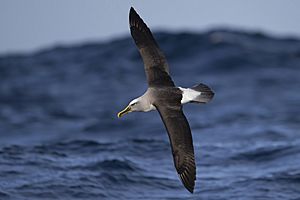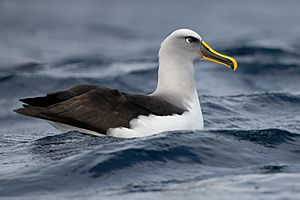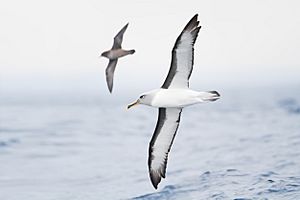Buller's albatross facts for kids
Quick facts for kids Buller's albatross |
|
|---|---|
 |
|
 |
|
| Conservation status | |
| Scientific classification | |
| Genus: |
Thalassarche
|
| Species: |
bulleri
|

The Buller's albatross (Thalassarche bulleri), also known as Buller's mollymawk, is a medium-sized mollymawk. It is part of the albatross family.
These birds make their homes on islands near New Zealand. They find their food in the waters off Australia and the southern Pacific Ocean.
Contents
What is a Buller's Albatross?
Buller's albatrosses are a type of albatross called mollymawks. Albatrosses are large seabirds. They belong to a bird group known as Procellariiformes. This group also includes shearwaters, fulmars, and storm petrels.
Special Features
Birds in the Procellariiformes group have some unique body parts.
- They have special nose tubes called naricorns. These tubes are on the top part of their beak. Albatrosses have their nostrils on the sides of their beak.
- Their beaks are also special. They are made of seven to nine hard, plate-like sections.
- They can make a special oil in their stomach. This oil is used to protect themselves from predators. It also gives a lot of energy to their chicks. Adults use it for their long flights over the ocean.
- They have a salt gland above their nose. This gland helps them remove extra salt from their bodies. They drink a lot of ocean water, so this gland is very important. It lets out a salty liquid from their nose.
Where Does the Name Come From?
This albatross was named after Walter Buller. He was a famous New Zealand scientist who studied birds.
What Does It Look Like?
A Buller's albatross is about 79 centimeters (31 inches) long. It has a silver-grey forehead and a grey head and throat. There is a black patch around its eyes. It also has a white crescent shape behind and below each eye.
Its back, upper wings, and tail are dark grey. Its lower back and belly are white. The underside of its wings is white with a black tip. It has a wide, dark band along the front edge of its underwing. Its beak is large and black. It has yellow on the top part of its beak and at the tip. Young albatrosses have a darker head and a brown beak.
How Do They Live?
Making a Home and Raising Chicks
Buller's albatrosses live in large groups called colonies. They usually build their nests on cliffs or steep coastal areas. They also nest in grassy fields and on hills covered in tussock grass. Some birds in the Snares Islands even nest under trees further inland.
Their nest is a mound made of soil, grass, and roots. They build it in a dip in the ground. Breeding starts in December. On the Snares Islands, eggs are laid in late January. Both parents take turns sitting on the egg. This incubation period lasts about 60 days. Each parent usually sits for about 10 days at a time. After the chick hatches, it takes about 170 days for it to grow enough to fledge (fly for the first time). These albatrosses breed every year.
What Do They Eat?
Buller's albatrosses eat a variety of sea creatures. Their diet includes squid, fish, tunicates (sea squirts), octopus, and crustacea (like crabs and shrimp).
Where Do They Live?
| Location | Population | Date | Trend |
|---|---|---|---|
| Snares Island | 8,877 pairs | 1999 | Increasing |
| Solander Islands | 4,912 pairs | 1999 | Increasing |
| Forty-Fours | 16,000 pairs | 1998 | |
| Big Sister Island & Little Sister Island | 2,130 pairs | 1998 | |
| Rosemary Rock | 20 pairs | 1998 | |
| Total | 64,000 | 1999 | Stable |
Buller's albatrosses are endemic to New Zealand. This means they are only found there naturally. They breed on several islands:
- Snares Islands
- Solander Islands
- Chatham Islands (including Big and Little Sister and Forty-fours Island)
- Three Kings Islands (Rosemary Rock)
Adult birds look for food between 40°S and 50°S latitude. This area stretches from Tasmania to the Chatham Rise. Young birds and adults not breeding fly across the South Pacific. Many of them feed each year in the Humboldt Current off the coasts of Chile and Peru.
How Are They Protected?
The IUCN used to list Buller's albatross as a vulnerable species. This meant they were at high risk of becoming extinct. However, new studies showed there were more birds than first thought. So, in 2008, their status was changed to Near Threatened. This means they are not in immediate danger, but their numbers need to be watched.
In 1999, there were an estimated 64,000 Buller's albatrosses. About 31,939 of these were breeding adults.
- 8,877 pairs were on the Snares Islands.
- 4,912 pairs were on Solander Island.
- 16,000 pairs were on Forty-fours Island.
- 2,130 pairs were on Big and Little Sister.
- 20 pairs were on Rosemary Rock in the Three Kings group.
The population on the Snares Islands has been growing. The population on Solander Island has also increased by about 18% since 1996. Most of the islands where they breed are protected by law. However, the colonies on the Chatham Islands are on private land.
Threats to Albatrosses
Buller's albatrosses are often caught by accident in longline fisheries near New Zealand. This is called bycatch. Even though some fishing methods were banned in 1992, squid trawlers still sometimes catch them. Also, a bird called the weka (Gallirallus australis) was brought to Big Sister island. Wekas might eat albatross eggs and chicks.
Images for kids
See also
 In Spanish: Albatros de Buller para niños
In Spanish: Albatros de Buller para niños



